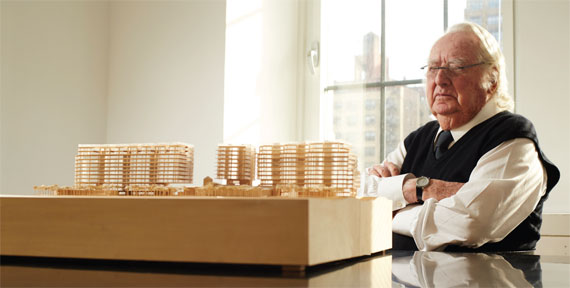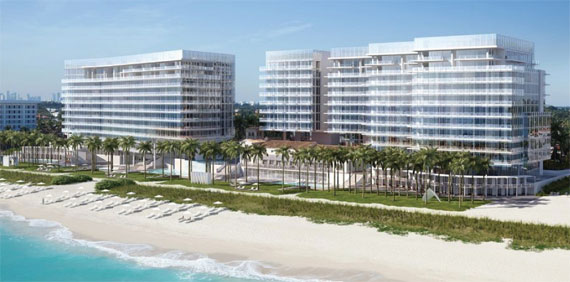Trending
Meier makes mark in Miami

If all goes according to plan, über architect Richard Meier’s foray into the boisterous Miami Beach development scene should bear fruit just in time for the bustle of Art Basel in the first week of December. That’s the targeted — and possibly optimistic — opening date for the revival of the massively expanded Surf Club, once a swank members-only emporium for drinking and sunning that is soon to be transformed into a Four Seasons hotel-and-luxury-condo complex, all three towers of it hovering over the beach.
In its previous incarnation, the Surf Club – designed by Russell Pancoast in 1930 in the style of a Mediterranean villa, with ornate ballrooms and beachfront cabanas – was a favorite spot for luminaries like Winston Churchill and Elizabeth Taylor. The core of the club is being preserved and renovated, and will feature the main entrance to the much larger complex now growing around it. The 80-room hotel will be at the complex’s center, flanked by two 12-story residential towers with 150 apartments and penthouses. The intent all along, Meier says, was to save as much of the original building as possible, given its beauty and historic significance.
Far from reducing his workload or resting on his considerable laurels, the 80-year-old Meier and his partners are also wrapping up construction on several other projects, including the HH Resort and Spa in Gangneung, South Korea; the Leblon office building in Rio de Janeiro; the 140-unit Rothschild Tower in Tel Aviv; the Cittadella Bridge in Alessandria, Italy; and Teachers Village, a mixed-use development in Newark, New Jersey.
In a recent conversation with The Real Deal, Meier took evident pleasure in noting how well some of his older works have held up, both aesthetically and structurally, and acknowledged an enduring fondness for one of his crowning achievements, the Getty Center in Los Angeles. He also conceded that despite continuing to take on projects across the globe, he is not quite as peripatetic as he once was.
After all these years, do you still get a thrill traveling around the world and leaving your imprint on the landscape?
The nice thing about working in all these different places is that you learn a lot. We’ve been doing this wonderful hotel in Korea; it’s for Hyundai. And it’s a terrific company — you learn about them while you’re designing the project. Working around the world is really terrific in that respect. Been to China a number of times, with projects there. We’re doing something in Tokyo. But I don’t travel as much as I used to.
Are you slowing down?
No, not in terms of being in the office, but in terms of traveling, I travel less. But it’s too much fun to not keep working.
But you must delegate quite a bit.
Oh, yes, absolutely. We’re doing this terrific project — The Surf Club in Miami Beach, and we’ve got three or four people in the office who are intimately involved in what’s happening there.
Is that still on schedule? Do you have an opening date?
Well, it’s under construction. I don’t think we have an actual date yet.
We’d heard that you planned to have it open in time for Art Basel.
Well, I hope so. There are a couple hundred people working on the site. It’s amazing. It’s a great site, too — right on the beach. You look out and you see the ocean. It’s terrific.
I understand that you’ve decided to acquire one of the residences yourself.
I have an apartment that has views of the water, of the beach, and from that apartment I can also see the sunset over the bay.
Is that a first, having a home in one of your own buildings?
Yes. All I need is time to go there.
I was wondering, since this is an oceanfront property, whether you have a
concern about a possible rise in sea levels over the long term. Is that something that you’ve addressed?
The height of the building is such that I can’t imagine in the next 100 or more years the sea rising to the level of the first floor. Because that’s raised about — I can’t remember exactly — four or five feet above the ground and there’s landscaping between it and the water. As you know, you have a walkway right-of-way that belongs to the city and on the other side of that there’s a dune. So at this location I don’t think that’s a problem.
How difficult was it in this case to incorporate an existing and much older structure into a new and much larger building?
We kept the old structure and incorporated it into the new building so that the entrance to the new building is really through the old building.
Should architects try, as much as they can, to preserve the old?
I don’t think you can answer that question. Just because it’s old may not mean it’s worth saving. You have to look at it, and say, ‘Is this of a certain quality that is worth preserving?’ In the case of the Surf Club it certainly was, because it’s a wonderful building, but I don’t think you can say that anything that’s old you have to save just because it’s 40 years old.

Meier’s rendering for Miami Beach’s Surf Club, which will feature a hotel flanked by residential towers.
In your long career, as you look back on it now, are there some projects that you’re more fond of than others? Do you have an emotional attachment to some of them?
That’s a good question, because there are projects that I did, say, 30 years ago, or more, that I hadn’t been back to. But now I’ve had occasion to go visit them, either because I’m traveling, or because of a change of ownership, any number of reasons, and I look at them and say, ‘Gee, that’s terrific. I’m really happy with that.’
I look at some of the early houses, which now have different owners than they did when I designed them, and I look at how beautifully they’ve been cared for. They may have been done 30 or 40 years ago, but they look brand new because people have really looked after them. That’s even true of public buildings. When I’m in Atlanta, I visit the High Museum, and I say, ‘Gee, that’s great,’ you know. Or Frankfurt, or any number of places. If I’m ever
seriously depressed, I just
have to go to the Getty.
It’s an astonishing place. It must have been terribly exciting to be able to build on that kind of a site, with that spectacular view of Los Angeles.
You’re right. It’s exciting. I haven’t been back to L.A. for a number of years, and I was talking with someone just the other day, and he said, ‘You can’t believe how the landscaping has grown in. It looks like it’s been there forever.’
Do you have a favorite project? You’ve done projects all over the world, and you’ve really left your mark. Is there one that stands out above all others — a favorite child?
The thing about the Getty is that it’s a public place, and the public goes there and enjoys it and appreciates it. I can’t tell you how often people come to me, or I meet them, and they say, ‘I went last week to the Getty and we had such a wonderful time and we were just so busy walking around that we never got into the museum.’ I guess that’s a compliment. They just love going there, having lunch, walking around, looking at everything. I mean, it’s terrific. So, it’s the public buildings that are really the most important to me.
Is there a building by another architect that inspires you still?
There are so many good architects today. I get a few different journals from around the world, and it’s remarkable the quality of architecture in South America, in the United States, in Europe. I think there’s a better quality of architecture today around the world than there was 50 years ago.
I imagine that when you were starting out, you admired people like Frank Lloyd Wright and Philip Johnson.
Yes, certainly. Mies van der Rohe, Le Corbusier, Alvar Aalto — there’s so many.
Were you aware of taking cues from any of them?
No, not really. You can admire the work of others. They’re important influences.
What do you think is your signature element, the thing you go to most when designing?
I think it’s the quality of the spaces, the use of natural light, the relationship of the building to its context — all these things are very important.
You’re an artist — you consider yourself an artist. I hear you’ve been doing a lot of collages over the years.
That’s right, and I’m still doing them. I’m actually doing some very big ones right now. I have a studio where we have our model museum, in Jersey City, a studio space where I go and work on occasion and do some very large collages. It’s great fun.
Have you had any gallery shows?
I’ve just had a show at the State Russian Museum [in Saint Petersburg], and I had a show last year in Zurich, in a gallery.
As you look back on what, by any measure, must be regarded as a remarkable career, do you have an overall assessment of what you’ve done?
I think I’m very proud of the things that we’ve done over the years, without question. But I’m also looking on to the next thing. It’s nice to look back at different projects, and yet I look forward to the conclusion of the construction of the Surf Club. In Tel Aviv, I look forward to that being finished. We’re finishing the project in Teachers’ Village in Newark. There are so many things that are coming to conclusion.




